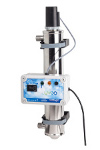- Home
- Private individual
Private individual

Limescale
Limescale is the common name for calcium carbonate deposits. It is naturally present in water and its concentration determines the hardness of the water. The higher the concentration, the harder the water. Hardness may be expressed in degrees or in mg/l. Calcium carbonate or scaling considerably reduces the efficiency of hot water systems, and also shortens their life cycle. It is deposited in pipe systems and household sanitary water systems. COMAP WT markets various types of equipment for the treatment of calcium carbonate, either physically or chemically. More detailed information can be found in our product lines: SOFTENING / ANTI-SCALING / COMBINED TREATMENT SYSTEMS.

Filtering
Household water systems can be filtered at several points, depending on the purpose of the filtering. Sediment (solid matter in suspension in the water, such as mineral, metal or organic particles, larger than 5 µm) is filtered on the incoming main water supply. The water is filtered through a porous structure that traps solid pollution. The COMAP WT filter product line includes various types of expendable cartridge, washable or self-cleaning filters. Water is also filtered at the water points (a water point is a water utilisation point, such as a tap or a shower, etc.). This type of filter is installed just upstream of the water points concerned, and is generally used to eliminate elements the consumption of which should be avoided: nitrates / pesticides / herbicides / heavy metals / bacteria. All this equipment is fully described in our FILTERS product line.

Public water systems
Public water supply systems have to be protected against the risk of accidental bacteriological pollution of the water distributed. Various processes exist, and these may be chemical (based on liquid or gaseous phase chlorine) or physical, by UVc disinfecting. The physical UVc disinfecting treatment may be recommended for household systems, on public supply water, and especially on water from wells, boreholes or sources that may be used by an individual household. COMAP WT offers a range of low output (2 to 5 m³/hr) UVc disinfecting treatment systems with, if necessary, the appropriate systems for sampling and monitoring the operation of these systems. Details of our UVc systems are included in the UVc DISINFECTING and COMBINED TREATMENT SYSTEMS product lines.

Sanitary hot water / bacteria hazard
The prevention of health hazards related to legionella and other bacteria, in hot water systems, is a constant problem in buildings that receive the public. The problem concerns both old systems that may be difficult to operate, and also new systems that can rapidly become contaminated by bacteria. Appropriate UVc radiation kills both legionella and all other bacteria. Although the risk of legionella contamination is lower in household systems, it remains possible, depending on the type of system and the volumes of sanitary hot water stored. A contaminated system should be chemically disinfected before the UVc treatment system is installed. Details of all these UVc disinfecting systems are given in our UVc DISINFECTING product line.

Rain (runoff) water
French regulations applicable to the recovery of rain water (runoff), and its utilisation inside and outside buildings, are defined in the corresponding ministerial directive of 21st August 2008. At present, runoff water may be used for household purposes if it is collected from roofs that are not accessible to the public, and that do not contain lead or asbestos. This utilisation is limited to watering gardens and vehicle washing, for outdoor applications, and to floor washing and toilet flushing water, for indoor applications. If a water treatment system is installed on this runoff water supply, then the water may also be used for washing household linen (washing machines), but only in private domestic applications. COMAP WT markets systems that are specifically designed for the treatment of rain water for household utilisation. Full details are given in our COMBINED TREATMENT SYSTEMS product line.

